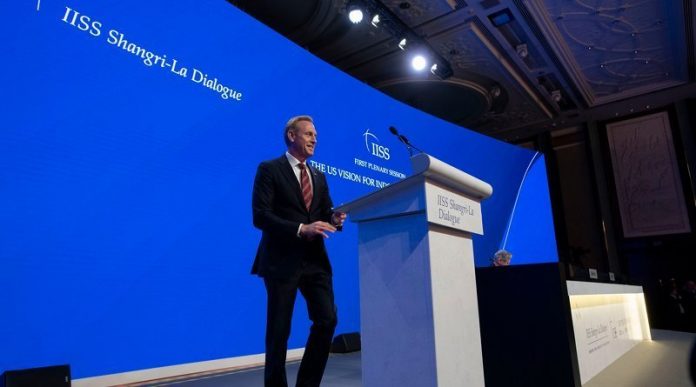The Shangri La Dialogue 2019 (SLD) held on May 31-June 02 not just reaffirmed the continuation of great power rivalry between the US and China but gave all possible signals that the pivot of this rivalry will now be in the Indo-Pacific region, evidence of which are already substantive. While the US took lead in the Dialogue through the presence of Acting Secretary of Defense Patrick Shanahan, China led the second day’s proceedings on equal footing. China not only negotiated hard for representation at the highest level but also was forcefully assertive in countering allegations laid against Beijing by the US. While most of the allegation-counter allegation ran in innuendos and indirect references, references to China from the US and vice versa were apparent.
In the Dialogue, the US underscored its Indo-Pacific strategy by calling the region its “priority theatre” and by specifying the Trump administration’s enduring policy, resource and research focus on the region, drawing a distinction from the past resolve, or lack thereof. Importantly, Washington recognized the interdependence of security and economics, drawing a clear definition of national security as ‘economic security’. Outlining the details further, Secretary Shanahan assured its partners that the US government is devoting significant resources to the Indo-Pacific mission with an investment focus of $104 billion, most ever, in the areas of research and development. Furthermore, the US consolidated on its Indo-Pacific promise by another $125 billion in operational readiness and sustainment for the next fiscal year.
The main purpose of a renewed assurance from Washington is China’s growing power differential with the US. China’s assertive growth has shrunk the operational space for the US in the Asia-Pacific and is rapidly moving towards the centre of the Indo-Pacific with a strategic focus on the Indian Ocean. Moreover, the US’ inward looking approach under President Trump along with his administration’s non-committal approaches towards allies like Japan and South Korea has eroded the alliance trust and has necessitated countable strategic reassurance from the US.
Similar sentiments apropos the Indo-Pacific region have concerned the US’ allies, partners and friends in the region. The sentiment of ‘America first’ has come to dominate the security and economic concerns of the countries of the Indo-Pacific region, leading to eroding trust in the US willingness to stand by its partners in the region, should crises arise. Resultantly, there is a great regional flux amidst countries of the Indo-Pacific swaying between security assurances from Washington and growing economic dependence on Beijing. As such, the SLD 2019 did precious little to assuage the apprehensions of Indo-Pacific countries, while on the contrary establishing firmly that great power competition between the US and China is likely to continue unabated. Such beliefs were entrenched on the second day of the Dialogue when General Wei put his points across.
China, led by General Wei Fenghe, State Councilor and Minister of National Defense, countered the US Indo-Pacific vision without specifying the country’s name. China denounced what it called the creation of a “China threat theory” and proposed an alternate world view comprising an Asia-Pacific community with shared values as a counter to the Indo-Pacific conception. While attempting to present an alternate regional order which was for the Asians and by the Asians, General Wei’s dismissal of the US’ Indo-Pacific strategy was apparent in his announcement of adopting a military strategy of active defense, which he defined as a military strategy which ‘adheres to the principles of defense, self-defense and post-strike response.’ He also justified construction of islands and their militarization by China as its legitimate right to carry out construction on their own territory. To be sure, in China’s denial of aggressive behaviour and justification for the same lies the growing resistance of Beijing in providing manoeuvrability to Washington in the Asia-Pacific.
Whither Middle Powers?
The SLD 2019 evinced penchant for a reinforced role in the Indo-Pacific by some middle powers led by Australia, Japan, and France too. While all the three countries agreed that only a reinforced Indo-Pacific strategy is likely to consolidate the rule of law in the Indo-Pacific to foster peace and stability as well as economic prosperity, among regional countries, all the three countries depicted special focus for the Indian Ocean with India as a focus of strategic cooperation in the Indo-Pacific. Australia and France both drew heavily on the Indian Ocean with India as a pivot including Australian ship visit to Chennai port and France’s carrier strike group’s recent visit to the Indian Ocean and Southeast Asia.
India, however, was conspicuously absent in the Shangri La Dialogue, except mentions by the participating countries, especially the US, Australia and France. India had a real opportunity to build on the gains made since last year Shangri La Dialogue, both in working multilaterally and bilaterally with Singapore. If anything, from last year’s Keynote speech by Prime Minister Modi to this year’s absence, India has evinced only inconsistency vis-a-vis its security resolve in the Indo-Pacific region. The middle power consensus on the Indo-Pacific, led by the US, is an opportunity for India to scale up its regional role in the Indian Ocean and the larger Indo-Pacific.
All in all, the SLD 2019 stood for bold assertions of two different world views, one led by China and the other supported by the US along with a host of middle powers – underscoring one broad trend in the Indo-Pacific: great power rivalry in the region is here to stay.
The views and opinions expressed in this article are those of the author and do not necessarily reflect the official policy or position of The Geopolitics.

Vivek Mishra is a Research Fellow at Indian Council of World Affairs, New Delhi. He is also Assistant Professor (on leave) in International Relations at the Netaji Institute for Asian Studies, Kolkata and Deputy Director, Kalinga Institute of Indo-Pacific Studies, Bhubaneswar. He has been 2019 South Asian Voices Visiting Fellow at the Stimson Center, Washington D.C. and a Fulbright Visiting Scholar in the Saltzman Institute of War & Peace, School of International Public Affairs, Columbia University, NY for the academic year 2015-16. Vivek has completed his PhD in International Relations at Jawaharlal Nehru University (JNU), New Delhi. His broad research discipline is international relations and his areas of research concern probing American and Chinese security role in the Indian Ocean and Indo-Pacific and Asia-Pacific regions, including Indo-U.S. defense relations and the Indian defence sector.


